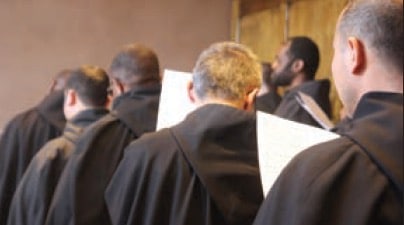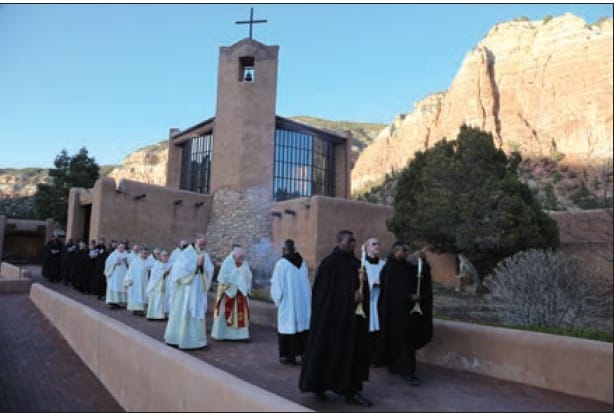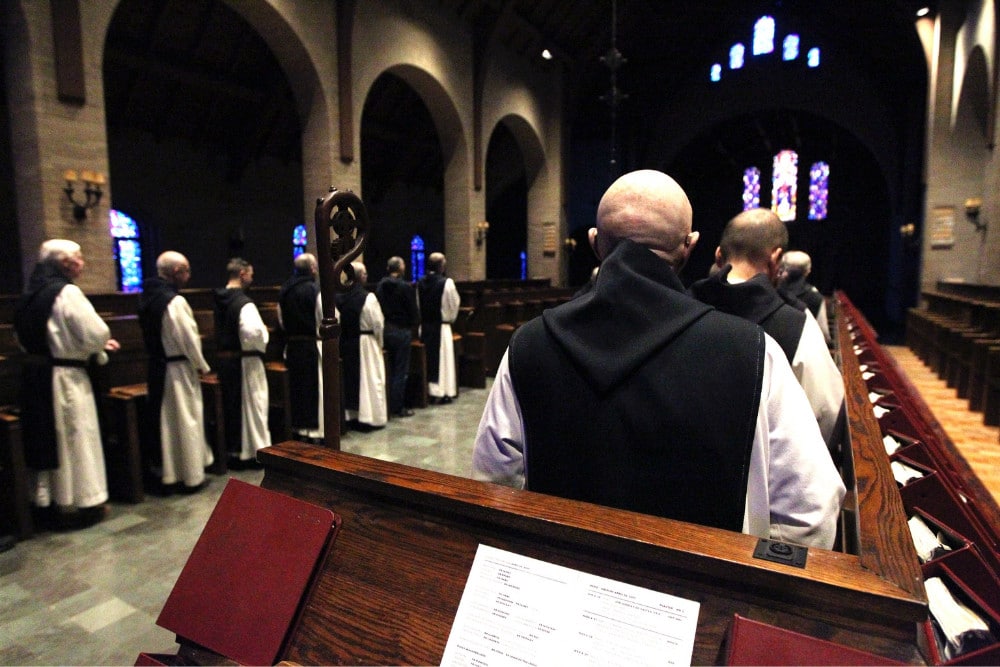In 1964, Father Aelred Wall, OSB (1917-84), and two other monks left Mount Saviour Monastery in New York to scout out remote locations to establish a new “daughter,” or off-shoot monastery. After visiting Maine and Minnesota, the monks came to northern New Mexico and laid eyes on a rancho in the wilderness of Chama Canyon, 75 miles north of Santa Fe. They declared, “This is it!” and established the Monastery of Christ in the Desert of Abiquiu (www.christdesert.org). At a time when religious communities are in decline across the West, the community has enjoyed remarkable growth, and is today home to 60 monks.
Brother Benedict, the community’s prior, who has been a monk for 41 years, believes the community has thrived for multiple reasons. He said, “We’re a joyful community, and joy is very attractive. We’ve had the same superior for 42 years, which leads to stability and continuity. And, we’re faithful to the monastic tradition and the teaching of the Church, and fidelity is important.”

The community is home to monks from 14 nations, with monks ranging in age from 20 to 91. The average age is 34. The community has enjoyed “phenomenal” growth in the past 25 years, Brother Benedict said, and has seen several daughter houses grow out of the community in Texas, Mexico and Costa Rica, with plans in the works for two additional houses. Moreover, another 50 men have applied for membership, but “we don’t have the cells for them. We have had so many vocations, it’s been a challenge.”
Beauty in the desert
The monastery is located in one of the most remote locations for a monastery in the world, Brother Benedict said, surrounded by “jaw dropping” beauty. To reach it, visitors must travel 13 miles along a dirt road off U.S. Route 84. The beautiful scenery along the way includes rock formations, high cliffs, mesas, tree-covered mountains and the Chama River in the center of the valley. The nearest town of 300 is a 45-minute drive away.
The monastery was designed by George Nakashima (1905-90), a famous Japanese-American woodworker and architect. Its adobe buildings blend with the landscape. The conditions have been somewhat primitive; both the church and guesthouses were heated by wood-burning stoves until 2014. Most of the electricity that supplies the community comes from a solar array, with a propane generator serving as a backup.
The community follows the Rule of St. Benedict. Prayers are typically sung, and begin at 4 a.m. and continue every few hours throughout the day until 8 p.m., Brother Benedict said, which “provides a real rhythm of prayer to life.”
The monks engage in daily manual labor to sustain their needs. Brother Benedict explained, “What is prime in our lives is prayer, and we fit the work in around it. We have to maintain our community, but it is prayer that gives us the strongest rhythm of the day.”
Part of the call to religious life, Brother Benedict added, is a “call to community.” And, just as married people do in a marriage, the monks can “bump corners” with one another and must learn to work out differences.
Community life
Brother Chrysostom, a former college instructor and Catholic convert from Chicago, joined the community a year ago. After visiting many communities, he knew the Monastery of Christ in the Desert was the place for him after experiencing its “simplicity and solitude.”
He continued, “In order to listen to God and engage in what prayer is all about, I needed the proximity and relationship with Jesus I found in the monastery. I tried to do it on the outside, but I am most successful in the unique and singular experience I have here participating in the silence, not bombarded by noise and distraction. As monks, we’re here to listen.”
Brother Chrysostom has engaged in a full range of physical labor since coming to the monastery, and as he was a teacher, he’s been tapped to teach English to the monks from Vietnam and Africa.
The superior of the community since 1976 has been Abbot Philip Lawrence. Abbot Philip is originally from Washington, became a Benedictine in 1964, and was ordained a priest in 1977. Brother Benedict described the abbot as “a wise man, who knows the importance of living in fidelity to the Rule of St. Benedict. His vision has kept us alive and growing.”
Community members wear a traditional Benedictine habit, with a specialized habit used for work. They leave the grounds as necessary, such as to visit the doctor or purchase food, but otherwise, Brother Benedict said, “our life is here; this is our family.”
Every two years, monks can leave the community to visit relatives.
Come and see
The monks seek to be a self-sustaining community, and operate a gift shop that sells religious items such as rosaries, paintings, candles and icons, many of which are made by the monks. Additionally, the community operates a guest house for visitors. Lay men and women, whether Catholic or not, are welcome to join the monks for day or overnight stays and participate in their lives of prayer; some 30,000 guests visit annually. Additionally, the public may send prayer and Mass intentions to the monks via their website.
Young men are welcome to come and explore the possibility of a vocation to the monastic life, but Brother Chrysostom said that those called have some common characteristics:
1. They are actively seeking God, 2. they are comfortable living in solitude, and 3. they have a sense of humor, as “living in community requires you to have a sense of humor.”
Brother Benedict said that the monastery is a place for “men of faith and prayer. You have to have a lot of generosity of spirit, which allows you to grow and make God’s will foremost in your life.”
He concluded, “If you’re not called to this life, you’ll find it difficult. We have ‘short sleep and long prayer.’ But for those called to it, it is heaven. It is unbelievably beautiful.”
Jim Graves writes from California.


